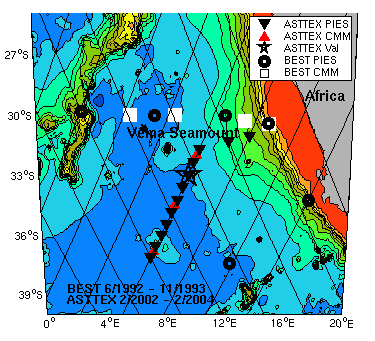

|
The injection of Indian Ocean water into the southeastern South Atlantic via the Agulhas Retroflection affects the thermohaline balance of South Atlantic surface, central, and intermediate waters, tending to add heat and salt to the South Atlantic. In the Cape Basin, the presence of water masses originating in the Indian Ocean creates strong thermohaline anomalies which when integrated through the water column produce anomalous acoustic travel time (tau) and baroclinic sea surface height (SSH) signatures. We develop and then apply a new technique: Gravest Empirical Mode- Enhanced Thermohaline Transport Analysis (GEM-ETTA) designed to statistically predict the presence and strength of this thermohaline variability in the water column based on historic hydrography and two directly measurable integrated properties: acoustic travel time and sea surface height. |
Historic hydrographic observations in the region (N=720) are synthesized and projected onto tau and SSH. Measurements of these properties are then used to estimate temperature and salinity profiles in the water column. Preliminary results from the application of GEM-ETTA to moorings deployed as part of the Benguela Sources and Transport (BEST) project in 1992-1993 are presented.The primary sources of Agulhas thermohaline anomalies are mesoscale features: Agulhas and 'Subantarctic' rings and eddies. An upcoming project will measure tau and SSH at mesoscale (~80 km) resolution using an array of inverted echo sounders and satellite altimetry deployed across the Agulhas eddy corridor into the South Atlantic. The application of GEM-ETTA to these data is expected to result in detailed thermohaline flux timeseries for the Indian-South Atlantic exchange.


